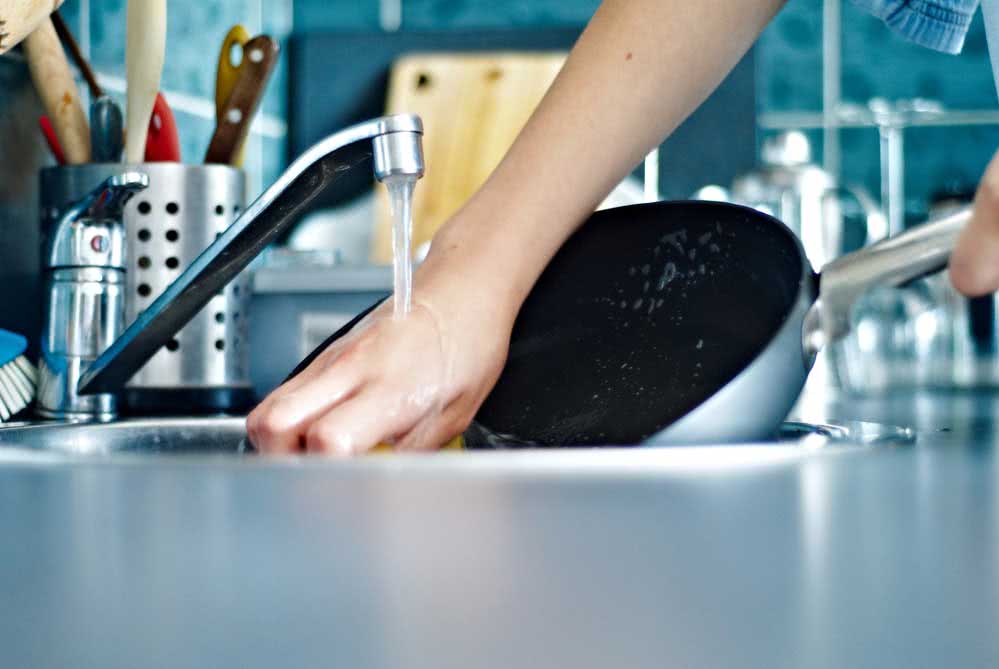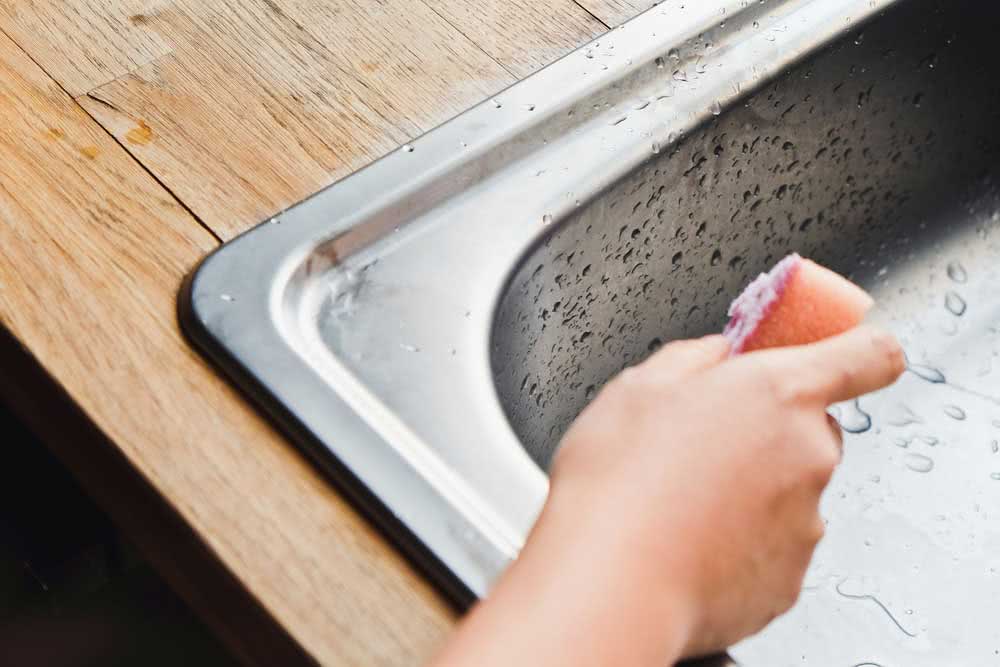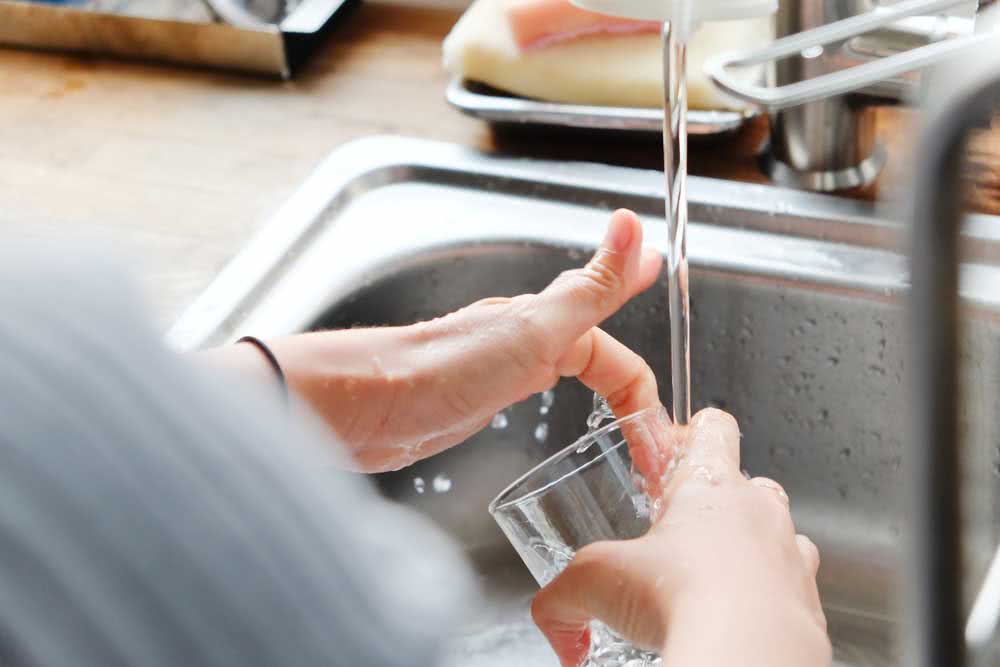Whether you like it or not, dirty dishes will accumulate in the sink. And the only thing left to do is chase away laziness and wash everything.
But did you know that you can make the dish washing process easier and faster and easier? Yes, it does!
And we will tell you all those miraculous tricks that will make all the difference in your life. Follow the post with us.
How to wash dishes: the right order for washing

The first step in making the dishwasher process less boring and tiring is to organize and separate the dishes. Check out the complete walkthrough:
Step 1: Separate the dishes
When collecting the plates and cutlery, form four groups on the sink counter: the first group is the glasses and bowls, the second group is the cutlery, the third group is the plates and the fourth and last group is the pans, platters and bowls.
Step 2: Eliminate excess dirt
Separated everything? Now start removing excess dirt from the dishes, starting with the dishes. Collect the leftover food in a basket, if you need it with the help of a paper towel for this.
The important thing is that the remains of food are not deposited in the sink basin, this can cause blockages in the sewage network, in addition to causing a bad smell and contributing to the proliferation of germs and bacteria.
Step 3: Start with the easiest one first
Start washing the dishes by the glasses and bowls. The explanation is simple: these dishes are generally fat free and easier to wash.
Other than that, while you wash these dishes, the rinse water gets wet and helps to soften the dirt on the dishes that will be washed afterwards, in the case of cutlery and plates.
Step 4: Cutlery and plate time
After washing the glasses and bowls, start washing the cutlery and plates. But it is important that they have already been « soaked » in the sink while you were washing the glasses, remember the previous step?
Therefore, remember to place the cutlery and dishes in the sink before starting to wash the glasses.
Step 5: More difficult cookware and crockery
Finally, the pans, molds, bowls and bowls used in preparing and serving meals should be washed.
These dishes are usually more dirty and greasy and, therefore, end up demanding greater attention.
The tip here is to put the pots and pans inside the sink basin as you rinse the plates and cutlery (remember the previous step, right?). This simple attitude helps to soften and remove excess dirt.
But what about those super dirty and greasy pans? Here, your best friend is hot water. It can be from the tap itself (if you have a heater) or from the stove.
To do this, put a little water (very little, enough to cover the bottom) and a few drops of detergent in the pan you want to wash and put it on fire. Warmth and soap will help remove fat.
It is worth remembering that it is not legal for you to pour oil directly into the sink. The oil can clog the plumbing, in addition to contaminating and polluting the environment by being discharged into the sewer.
To avoid this problem, always have a pet bottle or other container on hand to store the rest of the oil used in the kitchen. When the container is full take it to a used oil collection center.
Nowadays even schools and churches collect oil, so there’s no excuse.
Step 6: dry or not dry the dishes?
This doubt is controversial. Some are adept at the dish towel and dry everything as soon as the washing is finished. Other people, however, prefer to leave the dishes drying naturally on a drying rack or absorbent mat.
There is no right and wrong here, this decision belongs to each one. Want to save time and effort? Leave the dishes to dry on their own, then just store them.
Want to keep the kitchen organized and spotless? Dry and store everything.
If you decide to dry the dishes, be careful only with glasses and bowls, as the cloth ends up leaving lint on the glass. The ideal is to use a paper towel to dry this type of dishes.
Step 7: Clean the sink and stove
Did you finish washing the pots? Ufa! The crockery mission is over, now the other part begins: cleaning the countertop and the stove.
Well, there is no escape from this task. Start by cleaning the stove. How the appliance is cleaned will depend on how dirty it is.
In everyday life, in general, a wash of cloth with detergent is enough. But if you have made fries or other preparations that have left the stove unrecognizable, then it will be necessary to wash plates and buttons.
When you finish cleaning the stove, start cleaning the sink countertop. The ideal is to have a sponge just to clean the stove and the bench, ok?
Wash, rinse and dry.
Ready! Your sink is clean and sanitized.
How to wash dishes quickly

You saw how to wash the dishes in a simple and practical way, but is it possible to speed up this process?
The answer is yes!
And do you know the best way to do that? Cleaning and organizing the sink while preparing the meal. Believe me, this will save you a lot of time when washing the dishes.
So get used to saving what you are not using, such as ingredients on the counter and appliances that will no longer be needed.
Enjoy and also throw in the trash (recyclable, organic or in the compost) vegetable peels, packaging or leftover ingredients.
Did you get any dishes dirty while preparing food? So already find a way to wash it.
At the end, you will only have the dishes, glasses and cutlery to wash.
Write down one more nice tip for washing dishes quickly: lather everything first (respecting each group of dishes) and then rinse.
Want another tip? Do not overdo the amount of detergent. This will make you waste more time on the rinse to remove all the soap.
How to wash dishes in the cold
And if washing dishes is already a boring task, on cold days it is even worse. The cold water coming out of the tap is a real torture.
But how do you reconcile the need to wash dishes without having to keep your hands frozen?
The most practical solution is to install a heater. But this will represent an extra expense on your electric bill.
If you want to escape from extra expenses, then a good way out is to wear gloves while washing the dishes. This will prevent your hands from feeling the cold.
On the other hand, cold water makes washing the dishes a little more difficult, as the fat comes out more easily in hot water.
But you can resolve this conflict by heating a kettle of water and pouring it over the dirtiest dishes.
Can you do without washing dishes?

This is perhaps the most important question for you. And the answer is yes, you can go without washing dishes.
But don’t be fooled into thinking that the dishes will be washed magically and alone. The only solution in this case is to invest in a dishwasher.
However, you will still have to complete some tasks, such as removing excess dirt from the dishes before putting it in the machine.
There are hundreds of different models of dishwashers on the market. You must choose the one that meets your needs. But just to give you an idea, the average price of such a device starts at around R $ 1500.
Before buying dishwashers it is also important to analyze the space that you have available in the kitchen, since these appliances tend to be of considerable size and can end up clogging up your kitchen.
How to save water for dishwashing

Regardless of how you wash the dishes (in the dishwasher, in the hand, in cold water or in hot water), one thing is certain: water consumption is necessary.
Therefore, it is worth checking some tips on how to save water when washing dishes :.
- Turn off the tap! This tip seems obvious, but many people still wash dishes with the tap running.
- You also don’t have to leave that little trickle of water, let alone that drip pan. When we talk about turning off the tap it is to close it. Mercilessly.
- To save water you can also soap all dishes first before rinsing.
- Take advantage of this rinse water to soak the other dishes.
- Do you know that tip of removing the rest of food from dishes and other dishes? In addition to facilitating the process it also helps you save water.
- And speaking of soap, use only the amount needed for each dish. The cups, for example, can be washed with a minimum amount of detergent, while the pots must receive the dosage of soap according to their degree of grease and dirt. Remembering that the less detergent you have in the dishes, the faster the rinsing will be and the lower the water consumption.
So, now let’s wash a dish?



